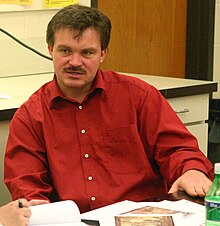Nikolai Grube
Nikolai Grube | |
|---|---|
 Nikolai Grube at the 1994 Maya Meeting | |
| Born | 1962 |
| Occupation(s) | Epigrapher Mayanist |
Nikolai Grube is a German epigrapher.[1] He was born in Bonn in 1962.[2] Grube entered the University of Hamburg in 1982 and graduated in 1985.[2] His doctoral thesis was published at the same university in 1990.[2] After he received his doctorate, Grube moved to the University of Bonn.[3] Nikolai Grube has been heavily involved in the decipherment of the Maya hieroglyphic script.[4]
Biography
He has served as professor of anthropology and art history at both the
In the 1990s he visited Naachtun in Petén and recorded the inscriptions on the Maya stelae.[8] He is credited with deciphering the ancient name of the kingdom from the hieroglyphic inscription on Stela 1 at the city.[8] Grube, together with fellow epigrapher Simon Martin, proposed that Maya politics of the Classic Period were dominated by two so-called "superstates" ruled by the rival cities of Tikal and Calakmul.[9]
From 1992 to 1995 Grube received funding from
Since 2014 Nikolai Grube is directing the project Text Database and Dictionary of Classic Mayan, which has a projected run-time of fifteen years.[11] It is housed in the Faculty of Arts at the University of Bonn and was established with funding from the North Rhine-Westphalian Academy of Sciences, Humanities and the Arts.[12] The goal of the project is to conduct computer-based studies of all extant Maya hieroglyphic texts from an epigraphic and cultural-historical standpoint, and to produce and publish a database and a comprehensive dictionary of the Classic Mayan language.
Notes
- ^ Coe 1992, 1994, p.236.
- ^ a b c d Houston et al 2001, p.486.
- ^ a b c Interdisciplinary Latin America Center at the University of Bonn (1) n.d.
- ^ Coe 1992, 1994, p.236. Houston et al 2001, p.486.
- ^ OCLC 47358325., inside back cover.
- ^ a b Coe 1992, 1994, p.228.
- ^ Martin 1998.
- ^ a b Reese-Taylor, 15 October 2010.
- ^ Webster 2002, p.168.
- ^ Interdisciplinary Latin America Center at the University of Bonn (2) n.d.
- ^ [1] Project information on the website of the Department of Anthropology of the Americas, University of Bonn. Accessed on March 31, 2015.
- ^ [2] Project information on the website of the North Rhine-Westphalian Academy of Sciences, Humanities and the Arts. Accessed on March 31, 2015
References
- OCLC 31288285.
- Houston, Stephen; Oswaldo Chinchilla Mazariegos; David Stuart, eds. (2001). The Decipherment of Ancient Maya Writing. OCLC 44133070.
- Interdisciplinary Latin America Center (1). "Nikolai Grube" (PDF) (in Spanish). Bonn, Germany: Interdisciplinary Latin America Center at the University of Bonn. Archived from the original (PDF) on 2011-07-19. Retrieved 2010-12-14.
{{cite web}}: CS1 maint: numeric names: authors list (link) - Interdisciplinary Latin America Center (2). "Board of Directors". Bonn, Germany: Interdisciplinary Latin America Center at the University of Bonn. Archived from the original on 2011-07-19. Retrieved 2010-12-14.
{{cite web}}: CS1 maint: numeric names: authors list (link) - Martin, Simon (22 May 1998). "Obituary: Linda Schele". The Independent. London: independent.co.uk. Archived from the original on 2022-06-21. Retrieved 2010-12-14.
- OCLC 47358325.
- Reese-Taylor, Kathryn (15 October 2010). "Naachtun: A Lost City of the Maya". BBC. Retrieved 2010-12-12.
- Webster, David L. (2002). The Fall of the Ancient Maya: Solving the Mystery of the Maya Collapse. London: OCLC 48753878.
See also
- "Works of Nikolai Grube". Google Scholar.
